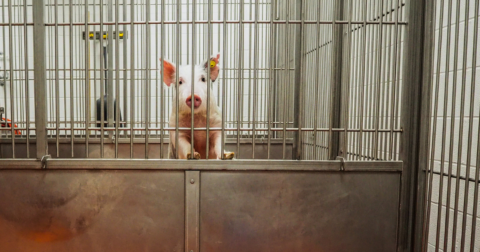News
Sentient Impact Report 2025
Policy•1 min read
Feature
To win over conservative lawmakers, some animal rights advocates are stressing spending cuts in their pitch.


Words by Jessica Scott-Reid
Animal advocates have long lobbied for policies to reduce the number of animals used in lab research. But the movement has found particular success in the second Trump administration with a strategy that highlights economic savings as well as the plight of animals. The National Institutes of Health has spent $5.5 billion each year on animal testing and research, so there are potentially billions at stake. In recent months, the National Institutes of Health, the Environmental Protection Agency and the Food and Drug Administration have all announced policies to reduce reliance on animal testing in lab research. Some animal advocates tell Sentient that they believe the strategy — highlighting cost-cutting — could work for farm animal welfare too, though not everyone agrees.
The push to reduce the number of animals used for scientific tests and experiments is several decades in the making. The strategy of reduction touted by federal agencies today, known as “reduce, refine and replace,” dates at least as far back as 1959, outlined in a book on how to make lab testing more humane.
Two groups working on this issue are Humane World For Animals (formerly Humane Society of the United States and Humane Society International) and People for the Ethical Treatment of Animals, or PETA.
Sara Amundson, president of Humane World Action Fund, says making the case on a variety of fronts, including costs, has been key to success. “No one thing was going to create that tipping point, but the amalgamation of, ‘How do you work with industry? How do you ensure there’s funding for non animal methods and strategies? How do you change the law to actually require the uptake of these non animal methods?’” All of these helped, Amundson says.
Amundson is well-practiced at pitching “stakeholders who may not actually care about animal suffering.” She says the key is knowing your audience, “then what messages are going to actually move them.”
Another more controversial group, White Coat Waste, has also been working on these issues. “We were DOGE before DOGE was a thing,” Justin Goodman, senior vice president of advocacy and public policy for White Coat Waste tells Sentient, referring to the Department of Government Efficiency.
Not everyone is a fan of White Coat Waste’s more recent tactics. An early donor to the group, Jim Greenbaum, recently criticized them for what he described as a “smear campaign” against an NIH official. The New York Times described the group’s founder as a “conservative activist who previously worked on campaigns to defund Planned Parenthood and to end the Affordable Care Act.”
Under the first Trump administration, White Coat Waste and the Humane World Action Fund under Amundson were both part of a wider effort to secure federal agency pledges to phase out animal testing on dogs, rabbits and other mammals by 2035, along with commitments to retire animals used in experiments. The momentum slowed under President Biden, but under Trump 2.0, the effort to end federally funded animal testing has once again moved forward.
In May 2025, the National Institutes of Health “terminated funding at Harvard University for studies that included sewing the eyes of young monkeys shut,” the agency stated via X. In a statement, PETA says this decision came after 31 months of the group’s relentless campaigning.
One Republican supporter, Congressman Earl “Buddy” Carter, told Sentient in an email that he supports “EPA, FDA, and NIH in replacing animal testing with innovative 21st-century science.” Carter embraces a number of arguments against animal testing, including reducing government spending.
The Office of Health and Human Services also tells Sentient via email that Secretary Robert F. Kennedy Jr. “has consistently raised concerns about outdated and unnecessary animal testing practices and supports efforts to modernize research while safeguarding public health.”
Delcianna Winders, associate professor of law, and the Director of the Animal Law and Policy Institute at Vermont Law School is one of a number of farm animal advocates looking to apply this tactic to farm animals. Winders argues the same approach to cost cutting can also be applied to the billions of dollars doled out by the USDA in the form of farm subsidies.
“It is very explicitly identified in Project 2025 roadmap,” Winders tells Sentient, calling the subsidies “low hanging fruit if you want to cut wasteful spending.”
Amundson, from Humane World for Animals, agrees, calling the idea to expand the movement’s strategy “the perfect continuum.”
Kathy Guillermo, senior vice president, laboratory investigations with PETA, expressed a similar take, writing to Sentient that “Subsidizing the production of dairy, eggs, and meat is undoubtedly a waste that harms animals and humans,” adding, “It should end.”
Subsidies are a rather nebulous category of government financial support, the contours of which have long been debated. Still, Winders argues that these payouts create an economic system that is “not a free market,” but one that creates an “uneven playing field.” Winders hopes to test whether reducing government funding for industrial animal agriculture might eventually reduce the number of animals being farmed too.
There are plenty of subsidies in the mix. The recent megabill came with a number of payouts to industrial animal agriculture and crop growers, including market protections and payouts to farmers for specific flock or herd losses. Sentient also reported in January 2025 that USDA researchers found egg industry bailouts for avian flu could also be hindering farmers from taking steps to improve their security protocols.
Goodman also sees the parallels between spending on animal testing and USDA subsidies, parallels that should appeal to lawmakers and officials strongly committed to reducing government spending, regardless of the recipient. “Taxpayer funding for advertising programs for industry” referring to check-off programs, also targeted in Project 2025, is one such example, Goodman says. “On paper those are things that should be on the chopping block.”
But Goodman doesn’t think the strategy can work in practice. “It’s much easier for people to oppose animal testing,” he says, as it’s rare to find a lawmaker of either party willing to take on the largest agricultural lobbies.
There is another factor that helped boost the case against animal testing that doesn’t transfer. The current administration “is particularly hostile towards the scientific community and is hostile towards public health agencies” Goodman says.
The same hostility is not directed toward agriculture and farmers. Farmers have not experienced the same kind of backlash that scientists have in recent years — although longtime opponents of pesticide use and genetically engineered crops do criticize global agriculture conglomerates and the farmers who work with or for them, and many of those voices are also opponents of animal testing and vaccines. Still, Goodman argues that, for most lawmakers, “farmers have a very good public image.”
Sentient asked Representative Carter and Secretary Kennedy, who has advocated for reforming farming policy, about the prospects for similar spending cuts at USDA for wasteful farm subsidies. Kennedy’s office responded that they “defer to USDA on questions regarding their funding,” and Carter’s office did not comment.
One strategy that may help bridge the gap for policy makers between animals used in research and farm animals, Chris Green, executive director of the Animal Legal Defense Fund, tells Sentient in an email, is the “USDA’s taxpayer-funded Wildlife Services, which slaughtered nearly 2 million wild animals last year –– many at the behest of the agricultural industry.”
While the department kills animals for a variety of reasons, “one of the primary purposes of Wildlife Services is to kill animals on behalf of the meat and dairy industries,” reported Vox in May. “Coyotes, European starlings, feral hogs, and pigeons — accounted for over 75 percent of the carnage,” it states, all of which, “come into conflict with animal agriculture.”
Another first step: Winders has created a clinic to better track USDA spending. Her hope is the research will help lay the groundwork for appealing to lawmakers interested in cutting costs. “Students in the Farmed Animal Advocacy Clinic at Vermont Law and Graduate School are working to produce a first-of-its-kind directory of these many subsidies,” she says, “because understanding the lay of the land in all its complexity is the first step” to challenging the kinds of government spending she characterizes as “colossal” and “harmful.”
Winders believes there could be opportunities to redirect some spending in better directions too. The Trump administration has shown willingness to fund some alternatives to animal testing, Winders says, so why not invest more in research and development of meat alternatives, including cultivated meat. Plant-based meat and cultivated proteins have received only a tiny amount of public funding to date (though the same can be said for many kinds of cutting-edge agriculture research, which tends to be publicly underfunded as compared to other sectors).
Tackling spending as a way to improve farm animal welfare may be a steep challenge, Winders concedes. “Removing these subsidies would be monumental,” she says, but still, she hopes for a shift in where the money goes, “to things that are more beneficial to society.”
Editor’s note: The Greenbaum Foundation is a donor of Sentient. Sentient donors have no role in editorial decision-making.
Clarification: This piece has been updated to remove the vague term “founding.”
Correction: This piece has been updated to reflect the new organizational name, Humane World Action Fund.